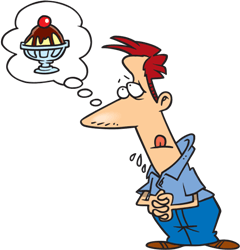Dynamic Verbs
and Stative Verbs
Examples and Exercises
Dynamic verbs vs. stative verbs can cause confusion among students.
Click Here for Step-by-Step Rules, Stories and Exercises to Practice All English Tenses
But really they aren't as difficult or as complicated as you may think.
The most important reason you need to know about these is because stative verbs can't usually be used in the progressive form. But more about that later!
Firstly, what do the words "dynamic" and "stative" mean?
They aren't very common words in everyday English, but they are grammar terms you will need to know to understand this subject.
Dynamic
"Dynamic" is an adjective which means something is moving or changing. In English grammar a "dynamic verb" means that the verb describes an action rather than a state. Dynamic verbs are sometimes known as "action verbs."
"Joe is chasing the bus."


Stative
"Stative" is an adjective which describes something as having a state,
or existing (this is a very uncommon adjective). In English grammar a "stative verb" means that the verb describes a state rather than an action.
Stative verbs are sometimes known as "state verbs."
"Kevin wants some
ice-cream."


So now you know the meaning of the terms, let's look at some examples!
First, here is a list of some dynamic verbs. You can see that they are all used to describe an action, change, or process. Most of them are used to describe an activity which has a start and an end.
Examples of dynamic verbs:
- eat
- walk
- learn
- grow
- sleep
- talk
- write
- run
- read
- become
- go
Example sentences with dynamic verbs:
- "I can't talk right now, I'm eating dinner."
Present progressive used to describe an action happening now.
- "Sorry, I'm out of breath because I've been
running."
Present perfect progressive used to describe an action that started in the past, continued for some time and has results now.
- "I didn't steal the necklace! I was sleeping
when someone broke into the shop!"
Past progressive used to talk about an action that was happening at a particular time in the past.
Examples of stative verbs:
- love
- hate
- like
- prefer
- doubt
- seem
- know
- own
- understand
Correct: "I like chocolate, but I prefer cake."
Incorrect: "I'm liking chocolate but I'm preferring cake."
Correct: "I don't understand you when you speak quickly."
Incorrect: "I'm not understanding you when you speak quickly."
There are also some verbs that can be either dynamic or stative, depending on their meaning and context in the sentence. I'm sure you know by now that there are many words in English that can have more than one meaning!
Examples of verbs that can be either dynamic or stative:
- think
- mind
- have
- smell
- sound
Example sentences:
- "I think
it is wrong to hit children."
Here, think is a stative verb. It means "to have an opinion" and it cannot be used in the progressive form in this case.
BUT
"I'm thinking about buying a new car."
Here, thinking is describing a process, or an action. This is something that is happening, rather than simply being. So here we can use the progressive form.
- "I don't
mind if we watch a movie tonight."
Here, mind means "be bothered by", which is a state of mind, not an action. Therefore, it is stative.
BUT
"I'm not being nosy. I'm minding my own business!"
Here, minding means "looking after" and is therefore a process and a dynamic verb.
- "I have
three brothers."
Have here talks about the family relationship the speaker has with her brothers and is therefore stative.
BUT
"I'm having a bad day today. I'll call you when things are better."
Having in this sentence means the speaker is going through the process of a bad day. It is therefore dynamic.
All this may seem complicated, but if you read and listen to as much English as you can, you will soon start to know which verbs sound right in the progressive. If you keep the basic idea of dynamic verbs vs. static verbs in the back of your mind, it will help you greatly.
Now, let's practice!

Dynamic verbs and stative verbs exercises
Reminder:- Actions that are in progress now => present progressive
Example: We are walking right now.
- States that occur now => simple present
Example: We want to walk now.
Exercises
Dynamic verbs and stative verbs exercise 01Dynamic verbs and stative verbs exercise 02
Dynamic verbs and stative verbs exercise 03
Dynamic verbs and stative verbs exercise 04
Dynamic verbs and stative verbs exercise 05
(Special exercise with verbs that have both dynamic and stative meanings)
Get Updates, Special Offers, and English Resources
Download your FREE GIFT (the first two chapters of
English Short Stories Book and Workbook)
as soon as you join!

By submitting your email, you consent to receiving updates and newsletters from us and to the sharing of your personal data with third parties for the purposes of sending you communications. We will not spam you. You can unsubscribe at any time. For more information, please see our privacy policy.





